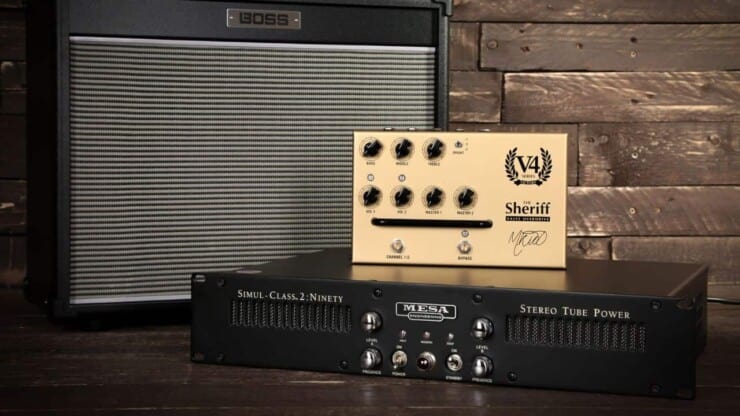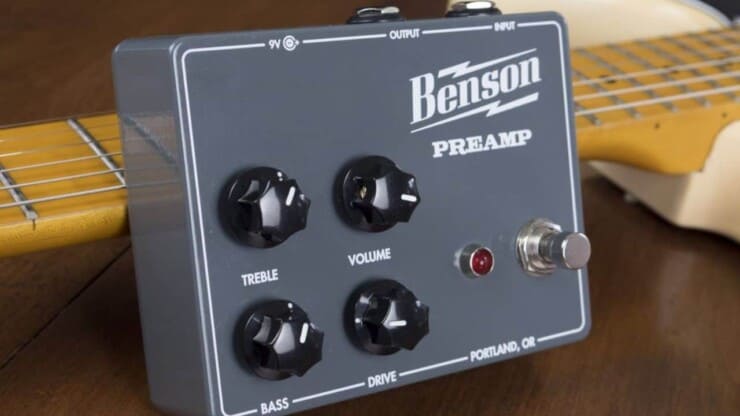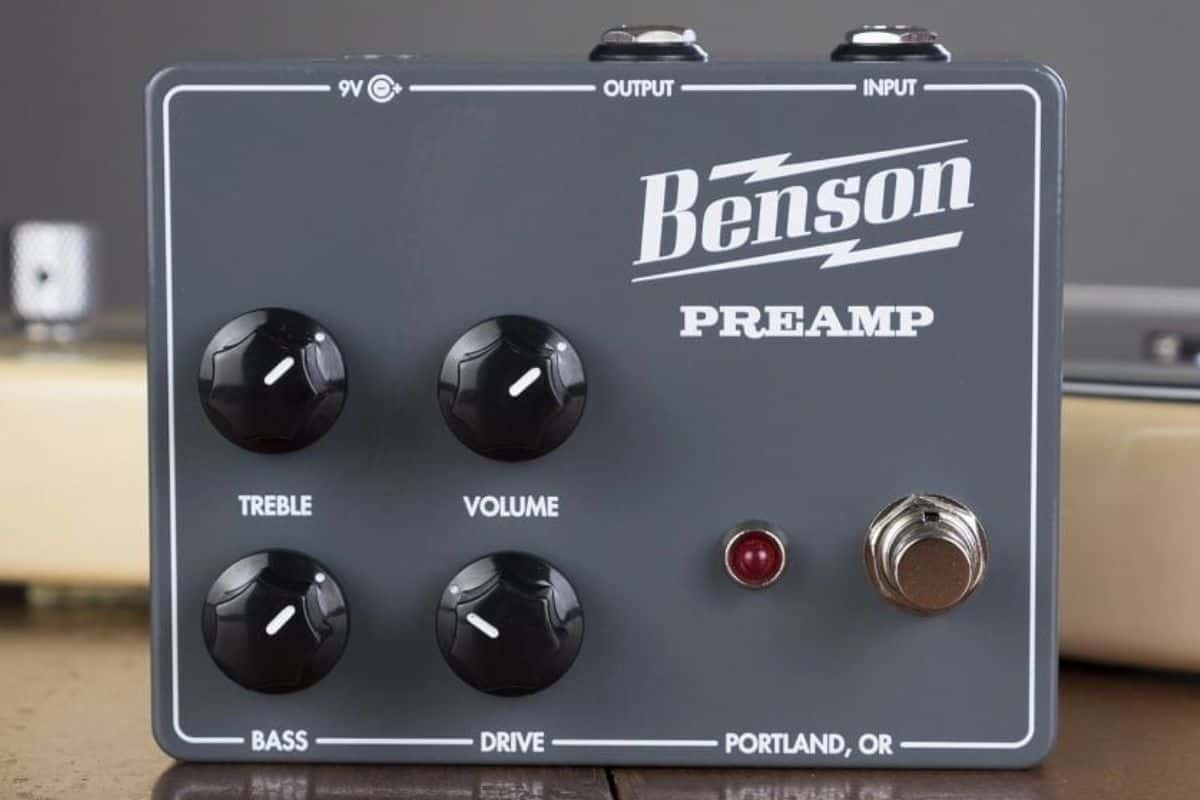Are you a newbie looking to learn the ins and outs of playing the guitar? Have you been struggling with understanding preamps and other similar concepts? If so, then this article is just what you need.
A guitar preamp is responsible for giving the guitar amp its core sound. In general, it is the section that will allow you to shape your amp’s character and overall voice. The preamp boosts the guitar’s output signal up to line level.
In this article, you’ll get to know all about preamps, what is a guitar preamp, what does a preamp do for guitar, how to use preamp pedals, what are the different types of guitar preamps, and more. Continue reading to know all about it.
What is a guitar preamp?
Guitar preamps are everywhere, and they’re commonly used by most contemporary musicians. Without preamps, microphones and instruments will not be able to produce output signals strong enough to be heard.
A preamp will take the low input signal from an amp or microphone and then boost it to line level. This is the standard signal strength to send unbalanced signals between components. This line-level audio will be sent to the audio interface, mixing desk, or power amp modeling for producing an audible sound.
Preamps normally vary in complexity and price range, with some of them having built-in preamp compression and EQs. Meanwhile, others merely boost the signal. As with most equipment, preamps can be analog, digital, or hybrid. Of course, each design will have its pros and cons. Analog units will use tube amp valves like Fender and Classic Marshall amps. These preamps need time for warming the tubes to deliver optimum sound. Sometimes, they break up and distort the more that they are pushed. This could be the sound that you’re looking for during recording sessions for electric guitars, bass guitars, or for affecting the guitar tone.
Digital preamps can be instantly used and sound cleaner than their analog counterparts. When pushed, these preamps will create more of a clipping distortion than what is made from tube saturation. You will be able to boost or cut bass and treble frequencies in the mixdown. However, most professional guitarists and recording engineers try and create something close to what gets used in the final mix. Studio engineers often use specific channel mic preamps for specific mics or for recording specific instruments. This is the case as some have unique tones that add color to the recording.
What does a preamp do for guitar?
The primary function of the preamp is to boost your electric guitar’s output signal to “line level”. A pure guitar signal will typically sound weak and anemic, something that will be evident when plugging a guitar directly into an audio interface or a PA system. Therefore, a preamp will be able to raise the guitar’s signal up to an audible volume. Moreover, it will ensure a more dynamically consistent sound after adding compression.
If you’re using a valve amplifier, it’ll be the tubes in the preamp section that generally cause this compression. Most valve amp manufacturers fit the preamps with 12AX7 (also referred to as ECC83) tubes, which is an industry-standard. 12AX7s are known for reacting well to electric guitars, which causes a musical-sounding breakup when the preamp is loud.
A preamp is also responsible for giving the guitar amp its core sound. In essence, this will be the section that allows you to shape the amp’s overall voice and character. It’ll also encompass the EQ controls that you’ll usually find on the amp’s front panel like bass, treble, and middle.
Preamp vs. amp
It is common to wonder if preamps and amps are the same or are they different. Basically, preamps will boost the weaker signals to the line level. Meanwhile, amps, on the other hand, will boost the line level in order for it to get sent to speakers.
For instance, a preamp will help the mic that outputs a weak signal, boosting it to a similar level as other signals. Once that is done, it will be processed by and sent through the regular amp to the speakers. Technically, both the amp and preamp do different things.

What are preamp pedals and are they necessary?
Many modern guitar players are always on the lookout for making their rigs more ergonomic and portable. For some, guitar amps can be unreliable and cumbersome, especially the ones fitted with tubes. The tubes fitted in valve amps end up expiring after a couple of years as they are heated up to high temperatures. Meanwhile, they are constructed using glass, which makes them brittle.
Preamp pedals can easily solve this issue. Most of them are built upon solid-state circuitry for ensuring longevity and better reliability. Many preamp pedals incorporate similar flexible features and controls that you’d expect to find on conventional amps like EQ knobs. Most preamp pedals also have gain circuits for producing overdrive and distortion.
Sophisticated preamp pedals will have even more to offer. Some of them feature multiple channels similar to amps, allowing you to switch between different sounds. There are even models that come equipped with comprehensive control sets, allowing you to dial in the perfect tones. Some of the coolest preamp pedals are the ones that are fitted with valves. Although they’ll need to be replaced, valve-powered ones are highly regarded as they sound more authentic than solid-state ones. Victory’s V4 preamp pedals will be a great example as it offers all the above and so much more.
From the perspective of usability, preamp pedals aren’t that far removed from traditional amps. However, if you’re intending on making the rig entirely pedalboard-based, it’ll be important to know that you might also require cab simulator pedals and power amps for completing the setup.
Deciding whether a preamp is needed will depend on your use case. Are you playing the guitar through a combo amp in your bedroom? If yes, then you will likely not need a preamp pedal. However, if you are playing gigs, or you’re a recording artist, then it’s recommended that you should get one.
How do you use a guitar preamp pedal?
The beauty of preamp pedals, just like the preamp in your combo or the amp head, will be that the signal that comes out will stay clean. This will allow you to crank the volume and shape the EQ. However, it’ll still send a clean tone to the rest of the signal chain. This will be especially effective when you’re using a preamp directly into the combo amp or head and cab.
Some guitarists do it for getting a more British tone from the ultra-clean American style amps without needing digital intervention. Preamps will be great when used right before delay and reverb pedals. Especially when the delay or reverb pedals are getting used heavily, the tone could get sloppy and dark.
By cleaning the dirtier frequencies before the signal hits the pedals, you’ll sound clearer and be able to get more out of these effects. There are many different ways you can incorporate preamp pedals into the signal chain. The best thing that you can do would be to experiment. Try it out before and after the effect pedals and see if you’re liking the resulting tone.
Different types of guitar preamps
It often feels like guitarists are on an eternal quest for sonic nirvana. It’s a journey that takes you to different parts of a signal path. Guitarists and musicians have to spend hours researching, evaluating, testing, and exploring everything from speakers to pedal effects and more to get the best sound out of your guitar. If you’re looking to explore the different possibilities of tone, you’ve probably thought of adding a preamp to your rig. With so many different types and models that you can choose from, which one should you prefer?

A guitar preamp is a device used for increasing the signal level, lowering the output impedance, coloring the tone, converting the signals from unbalanced to balanced, or the combinations of the above. All of these functions have their distinct uses. An onboard preamp will be different from rack-mounted preamps. Making sense of the types of preamps and their functions will help you decide which type of preamp you’ll need.
The basic principle of preamps
First, you’ll need to examine the basic principle of preamps. The output level of the bass isn’t high enough on its own to run even a pair of normal earbuds. Your priority would be to have a preamp capable of bumping the signal to a higher line level. This is the standard that most professional audio gear looks to conform to. Once you’ve brought the signal up to line level, it’ll be ready for the input of mixing consoles, power amps, soundcards, and other devices.
Onboard preamps
The first type of preamps that guitarists go for would be onboard preamps. If you’ve got an onboard preamp installed into your guitar, it’ll be considered to be “active”. Interestingly, the evolution of active electronics started all the way back in the late 60s when Ron Wickersham and Rick Turner joined forecast at Alembic. Their early work with the Bay Area rock bassists, Jack Casady of Jefferson Airplane and Phil Lesh of the Grateful Dead, paved the way for the now-ubiquitous active circuits commonly found in today’s devices.
Apart from adding gain, onboard preamps will also feature active EQs. These will either be 2-band (bass and treble), 3-band (bass, treble, and midrange), or in rare cases, 4-band (bass, treble, low mids, and high mids). Although some onboard preamps feature the ability to boost or cut different frequencies, others are largely boost-only. The amount of boost or cut can be expressed in decibels (dB). Take an example of a preamp like the Aguilar OBP-3. Its listed specs are ±18dB @40Hz for low frequencies, ±16dB @400Hz or 800Hz for mids, and ±16dB @6.5kHz for the highs.
These numbers make it evident that the preamp will be tuned for deep lows, punchy mids, and sparkling highs. Meanwhile, you’ll also get to dial in substantial boosts and cuts. Comparing the specs on different preamps will give you a clearer idea of how different preamp models perform. It’ll also help you avoid any mistakes that might cost you a lot of money. You should remember that these boost and cut specs will be for EQ only and not the actual gain level.
It’s also important to keep in mind that onboard preamps aren’t designed to drive a separate power amp. If you’re plugging an active bass into a power amp, you’ll hear something. However, the output level wouldn’t be high enough for driving the amp to its full specifications.
Stompbox preamps
Another common type of preamps available in the market is stompbox preamps. Many brands make pedal versions of onboard preamps and call them stompbox preamps. For instance, the Ken Smith P.A.P.A. (Preamp/Practice Amp) allows you to use Smith’s active circuit with any bass. The other stompboxes are comparatively more character-based, such as Tech 21’s SansAmp Bass Driver DI. It can easily simulate the tone of the bass amp. There is also the Radial Engineering Bassbone, which offers two EQ channels and multiple output options.
Many stompbox preamps tend to work with the magnetic pickups that are found on electric basses. However, using the preamps with piezo-pickup-equipped bass could be an issue. The output impedance of the piezo pickup is often too high to match the input impedance of the amp designed for magnetic pickups of the guitar. This mismatch normally results in less than optimal tones. This is why preamps like the Fishman Platinum Bass are often designed for offering a buffer for piezo pickups. These will alter the signal’s impedance level to match the amp’s input.
Lately, many amp manufacturers have adopted higher input impedances that make buffer preamps unnecessary.
Pedal-type preamps are often incredibly versatile little devices. They’ll give you the performance of an active circuit without actually needing permanent installation. They’re essentially an insurance policy in case your amp fails. Furthermore, they’ll give touring players a consistent starting point, having varying backlines and helping you quickly dial the right tone in a recording situation. Many of them feature an auxiliary input and headphone-out for making silent practicing much more convenient.
Rack-mounted preamps
Another popular type of guitar preamp is the rack-mounted preamp. Many guitarists love using a rack-mounted preamp for driving the power amp in a live situation. Many rack-mounted preamp models will come equipped for studio use as well. Many brands build rackmount models almost identical to the preamp section of the popular amps. There are devices like Eden’s WP100 Navigator that will allow you to get the brand’s signature tone while using a power amp or plugging it directly into a studio console.
Other preamps like the Demeter VTBP-201S are designed to be far more transparent. While they aren’t devoid of personality, devices like this will strive to attain a pristine response, allowing the natural tone of the guitar to take center stage. A rack-mounted preamp will either have tube input sections, solid-state input sections, or the option to switch between the two. Tubes are often sought after for their warmth and natural-sounding overdrive.
Meanwhile, solid-state circuitry is prized for its quick response, accuracy, and harmonic distortion. Although the general characteristic greatly influences the guitarist’s buying decisions, remember that the quality of the circuit design will have a massive effect on the unit’s performance.
A properly-equipped rack unit features high and low-gain inputs. This will compensate for different output levels of active and passive basses. The EQ section could vary from a graphic EQ to a simple bass/treble/mid arrangement to several bands of sweepable mids.
Apart from the EQ, many manufacturers will offer proprietary tone-coloration controls like Bass Intensifier and Aural Enhancer circuits found on SWR’s Marcus Miller preamp. The other features you may find are effect loops, compressor, mute switch, crossover for bi-amping, and multiple outputs. When talking about interfacing with other devices, the output section will be the most critical section of the preamp. For connecting with a power amp, first, you’ll have to know the power amp’s input requirements. Normally, for optimum performance, the input impedance needs to be at least 10x higher than the preamp’s output impedance.
For studio use, you should ensure that the preamp has a balanced line out. This is normally in the form of an XLR jack or sometimes a 1/4-inch TRS stereo jack. Your guitar produces unbalanced signals that are susceptible to hum and line noise, which is largely unacceptable for recording. A balanced lineout reduces the noise and conducts a clean signal to the audio interface or mixing console. The right preamp will greatly improve your sound while offering useful features. However, there is far more to choosing the right preamp for the job than simply buying the one that your favorite guitarist uses.
Conclusion
Thank you for reading. Hopefully, now you know a lot more about preamps, what is a guitar preamp, what does a preamp do for guitar, how to use preamp pedals, what are the different types of guitar preamps, and more. A guitar preamp is a tool responsible for giving your guitar amp its core sound. It is the section that’ll allow you to shape the amp’s character and overall voice. A preamp is an integral part of any guitar rig, and you must utilize it whether you’re a beginner or a seasoned veteran.
Image Credit:
Featured Image: Sustain Punch
Images: Andertons Music Co., Premier Guitar



